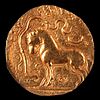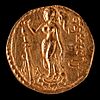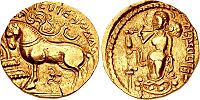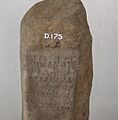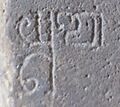Yūpa facts for kids
A Yūpa (यूप), or Yūpastambha, was a Vedic sacrificial pillar used in Ancient India. It is one of the most important elements of the Vedic rituals for animal sacrifice.
The execution of a victim (generally an animal), who was tied at the yūpa, was meant to bring prosperity to everyone.
Most yūpa, and all from the Vedic period, were in wood, and have not survived. The few stone survivals seem to be a later type of memorial using the form of the wooden originals. The Isapur Yupa, the most complete, replicates in stone the rope used to tether the animal. The topmost section is missing; texts describe a "wheel-like headpiece made of perishable material", representing the sun, but the appearance of that is rather unclear from the Gupta period coins that are the best other visual evidence.
Isapur Yūpa
The Isapur Yūpa, now in the Mathura Museum, was found at Isapur (27°30′41″N 77°41′21″E / 27.5115°N 77.6893°E) in the vicinity of Mathura, and has an inscription in the name of the third century CE Kushan ruler Vāsishka, and mentions the erection of the Yūpa pillar for a sacrificial session.
-
The word "Yūpaḥ" (

 𑁊) in Brahmi script in the Isapur pillar inscription.
𑁊) in Brahmi script in the Isapur pillar inscription.
Yūpa in coinage
During the Gupta Empire period, the Ashvamedha scene of a horse tied to a yūpa sacrificial post appears on the coinage of Samudragupta. On the reverse, the queen is holding a chowrie for the fanning of the horse and a needle-like pointed instrument, with legend "One powerful enough to perform the Ashvamedha sacrifice".
-
Samudragupta coin with horse standing in front of a yūpa sacrificial post, with legend "The King of Kings, who had performed the Ashvamedha sacrifice, wins heaven after conquering the earth".
Yūpa inscription in Indonesia
The oldest known Sanskrit inscriptions in the Nusantara are those on seven stone pillars, or Yūpa ("sacrificial posts"), found in the eastern part of Borneo, in the historical area of Kutai, East Kalimantan province. They were written by Brahmins using the early Pallava script, in the Sanskrit language, to commemorate sacrifices held by a generous mighty king called Mulavarman who ruled the Kutai Martadipura Kingdom, the first Hindu kingdom in present Indonesia. Based on palaeographical grounds, they have been dated to the second half of the 4th century CE. They attest to the emergence of an Indianized state in the Indonesian archipelago prior to 400 CE.
In addition to Mulavarman, the reigning king, the inscriptions mention the names of his father Aswawarman and his grandfather Kudungga (the founder of the Kutai Martadipura Kingdom). Aswawarman is the first of the line to bear a Sanskrit name in the Yupa which indicates that he was probably the first to adhere to Hinduism.
-
One of the yūpa Mulavarman inscriptions from Kutai, at the National Museum in Jakarta
Text
The four Yupa inscriptions founded are classified as "Muarakaman"s and has been translated by language experts as follows:
|
Muarakaman I |
Muarakaman II |
Muarakaman III |
Muarakaman IV |
Translation
Translation according to the Indonesia University of Education:
|
Muarakaman I |
Muarakaman II |
Muarakaman III |
Muarakaman IV |
The Yupas are now kept in the National Museum of Indonesia in Jakarta.







